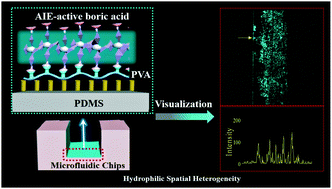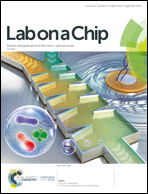In situ visualization of hydrophilic spatial heterogeneity inside microfluidic chips by fluorescence microscopy†
Abstract
Fluorescence visualization for hydrophilic spatial heterogeneity inside microfluidic chips is a long-standing challenge owing to the lack of fluorescent dyes with high contrast between the target and the background noise. Herein, we used boronic acid in aggregation-induced emission (AIE) molecules as an anchor group towards modified hydroxyl groups, and an in situ visualization approach for hydrophilic spatial heterogeneity inside microfluidic chips was demonstrated. This success is based on the high-contrast of fluorescent behaviors for AIE molecules in aqueous solution and their immobilization by hydroxyl groups inside the microfluidic channels. In comparison to conventional laboratory-based ex situ techniques, the proposed strategy provides a direct representation for hydrophilic spatial heterogeneity, including the quantity and distribution of hydroxyl groups. This discovery not only identifies a previously unknown variability in hydrophilic spatial heterogeneity inside microfluidic channels, but also guides an optimal hydrophilic modification method in the channels.



 Please wait while we load your content...
Please wait while we load your content...